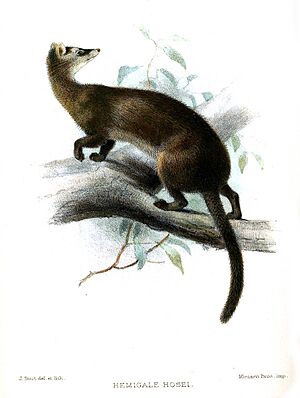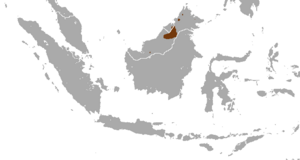Hose's palm civet facts for kids
Quick facts for kids Hose's palm civet |
|
|---|---|
 |
|
| Conservation status | |
| Scientific classification | |
| Genus: |
Diplogale
|
| Species: |
hosei
|
 |
|
| Hose's palm civet range | |
The Hose's palm civet (Diplogale hosei), also called Hose's civet, is a special animal found only on the island of Borneo. It's a type of viverrid, which are small, cat-like mammals.
This civet is listed as a Vulnerable animal. This means its numbers are going down. Experts think its population has dropped by more than 30% in the last 15 years. This is mainly because its habitat (where it lives) is being destroyed or damaged.
Diplogale is a monospecific genus. This means it's the only species in its group. The animal was named after a zoologist named Charles Hose. Oldfield Thomas named it in 1892. Charles Hose found the first civet in Sarawak in 1891.
We don't know much about Hose's civet. Most of what we know comes from 17 civets kept in museums around the world. The first live civet was found in 1997. It was studied for two months and then set free. No Hose's civets are kept in zoos or other places today.
Contents
What Does Hose's Civet Look Like?
Hose's civets have dark brown or blackish-brown fur on their backs and outer legs. Their bellies and inner legs are white or slightly brownish-white.
Their faces have dark rings around their eyes. They have very long, white whiskers that help them feel their way around. Their large, wet snout (nose) is a contrasting flesh color. Their two nostrils stick out and open on both sides.
The undersides of their feet are pale, and their footpads are brown. Their feet are partly webbed, with short hair between the pads. This might help them in wet areas.
Hose's civets are about 47 to 54 centimeters (18.5 to 21 inches) long from head to body. Their tails are about 30 to 35 centimeters (12 to 14 inches) long. They weigh about 1.4 to 1.5 kilograms (3 to 3.3 pounds). They have 40 teeth.
Where Do Hose's Civets Live?
Hose's civets have been seen in a few places in Malaysian Borneo, specifically in Sarawak and Sabah. They have also been found in Brunei. One civet was seen in Kalimantan at about 325 meters (1,066 feet) high.
Most sightings of this civet have been in lower mountain forests. They also live in old, mixed dipterocarp forests. These are forests with very tall trees.
Recently, a civet was caught and released in Brunei. A camera trap also took a picture of one in a lowland forest in Kinabalu National Park in Sabah. Another camera trap photo from Kalimantan might also be this species.
The most civets seen in one area were in the Sela'an-Linau Forest Management Unit in Sarawak. Fourteen pictures of Hose's civets were taken there between 2004 and 2005. This area might be a very important home for them.
Even though many records are from montane forests (mountain forests), they have been seen at lower heights too. For example, they were seen at 450 meters (1,476 feet) in Brunei and 600 meters (1,968 feet) in Sarawak and Sabah. This suggests they might live in different types of forests.
It's possible that Hose's civets like very humid places. They might prefer mossy forests, especially near mossy rocks and streams.
How Do Hose's Civets Live?
Hose's civets are crepuscular (active at dawn and dusk) and nocturnal (active at night). They are thought to spend more time on the ground than other viverrids. They might make their homes in holes between rocks or tree roots.
What Do Hose's Civets Eat?
We don't know much about what Hose's civets eat in the wild. But it's thought they look for small fish, shrimps, crabs, frogs, and insects. They probably find these foods among mossy rocks and streams.
The only civet ever kept in captivity ate only meat and fish. It did not eat fruit. This is different from most other civets in Borneo, which usually eat fruit.
Why Are Hose's Civets in Danger?
Losing their homes and damaged habitats are big problems for Hose's civets. This is mainly due to logging and turning forests into other types of land.
We don't know if logging bothers them too much. We also don't know if they can survive when their forest homes are broken up by slash and burn farming or logging roads. Hunting might also be a growing threat to them.
It's very important to study this species more. This will help us understand them better and protect them.
Protecting Hose's Civets
We don't know much about how many Hose's civets there are or how they move around. This makes it hard to plan specific ways to protect them.
No protected area is known to have a large population of these civets. However, some have been seen in Ulu Temburong National Park in Brunei and Mount Kinabalu National Park in Sabah. In Sarawak, no protected area is known to have a population of this species.
Their vulnerable status is based on their small living area and the large amount of deforestation and damage to their habitat.
Animals Similar to Hose's Civet
The Hose's civet looks a bit like the banded palm civet (Hemigalus derbyanus). Hose's civet was first called Hemigalus hosei in 1892. But in 1912, Oldfield Thomas realized their snouts and teeth were different. Their fur patterns were also different. So, he put Hose's civet in its own group, Diplogale.
Like the Hose's civet, the banded palm civet is also nocturnal and spends more time on the ground. But Hose's civet lives in a much smaller area, mostly in higher mountain forests.
The large snout and long whiskers of Hose's civet are similar to those of the otter civet (Cynogale bennettii). The otter civet is known to be semiaquatic (spends time in water) and has webbed feet. It mainly lives in lowland rain forests.


